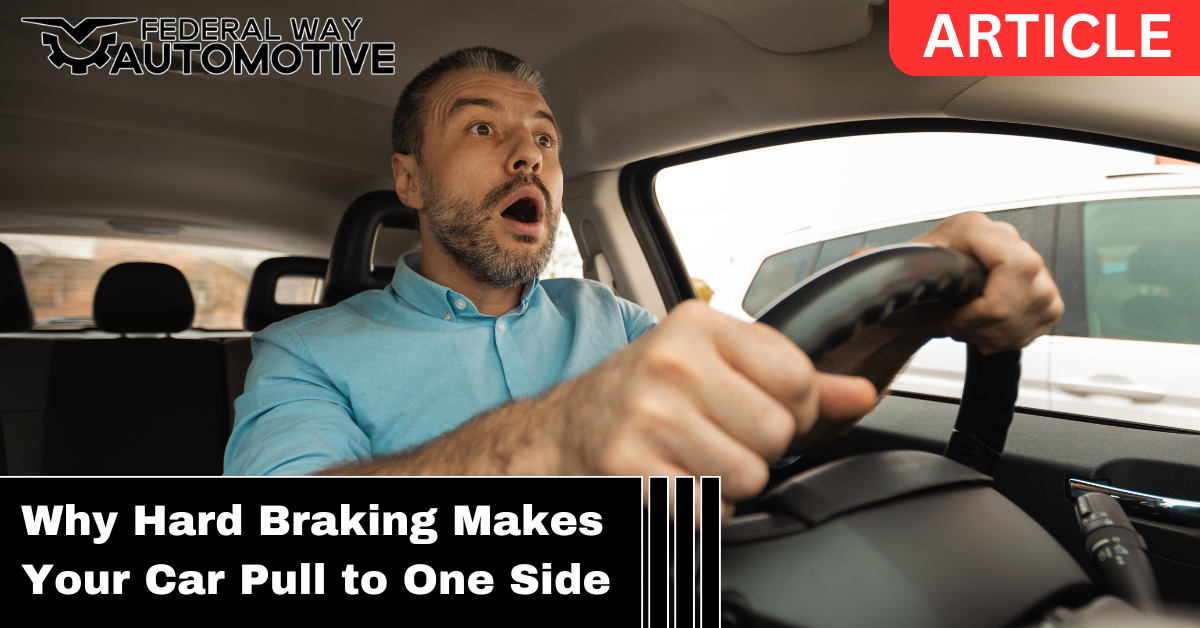If you’ve ever hit the brakes and felt your car veer sharply to the left or right, you know how unsettling it can be. A pulling sensation during braking is more than just uncomfortable — it’s a clear warning that something is wrong with your braking system. Left untreated, it can compromise your safety, reduce vehicle control, and increase your stopping distance.
At Federal Way Automotive, we frequently see drivers experiencing this issue, and the causes often boil down to a handful of common problems with brake rotors, brake calipers, or brake pads. In this article, we’ll explain the most likely reasons your car pulls to one side when braking, the symptoms to watch for, and how proper auto repair can keep you safe on the road.
Why Pulling During Braking Is Dangerous
Your brakes are designed to apply equal force to all four wheels. When one side isn’t working correctly, your car will pull to the stronger side, creating an imbalance. This can:
- Make emergency stops unsafe by reducing control.
- Cause uneven wear on tires and suspension components.
- Lead to longer stopping distances.
- Increase the risk of skidding in wet or icy conditions.
Ignoring the problem doesn’t just put you at risk — it also drives up repair costs later when related components wear out prematurely.
1. Uneven or Warped Brake Rotors
Brake rotors play a critical role in stopping power by providing a smooth, even surface for the brake pads to clamp against. Over time, rotors can warp from excessive heat, especially after repeated hard braking or downhill driving.
How it causes pulling:
A warped rotor creates uneven friction. When one side of the vehicle grips harder than the other, your car veers off course during heavy braking.
Symptoms to watch for:
- Steering wheel vibration while braking.
- Pulling strongly to one side under moderate to hard braking.
- Uneven or grooved rotor surfaces visible through the wheel.
Solution:
Resurfacing or replacing brake rotors ensures both sides provide even stopping power. At Federal Way Automotive, we measure rotor thickness and runout to determine whether resurfacing is possible or replacement is the safer option.
Prevention tip:
Avoid riding the brakes on long descents. Downshift when possible to reduce rotor stress.
2. Sticking or Seized Brake Calipers
The brake caliper houses the pistons that press brake pads against the rotors. If a caliper seizes or sticks, one side may apply constant pressure while the other side operates normally.
How it causes pulling:
A sticking caliper clamps unevenly, pulling the car toward the side with greater braking force.
Symptoms to watch for:
- Pulling to one side that worsens as brakes heat up.
- A burning smell after driving.
- Excessive brake dust on one wheel.
- Car feels sluggish even when not braking.
Solution:
Caliper rebuilds or replacements restore even function. Sometimes, simple lubrication and cleaning of the caliper slides are enough, but often replacement is necessary to ensure reliability.
Prevention tip:
Regular brake inspections can spot worn seals or corrosion before a caliper seizes.
3. Unevenly Worn Brake Pads
Brake pads wear down over time, but if they don’t wear evenly between the left and right sides, you’ll feel it when braking.
How it causes pulling:
One pad grips more firmly than its opposite counterpart, creating unbalanced stopping force.
Symptoms to watch for:
- Pulling only during braking, not during regular driving.
- Squealing or grinding noises when applying brakes.
- Pads visibly thinner on one side.
Solution:
Replacing brake pads in complete axle sets (both left and right) ensures even braking power. At Federal Way Automotive, we also check why the pads wore unevenly — sometimes it’s a sign of deeper issues with calipers or rotors.
Prevention tip:
Schedule routine brake inspections every 12,000 miles or annually, whichever comes first.
4. Suspension or Alignment Issues
Sometimes the cause of braking pull isn’t the brakes at all. Worn suspension components or improper alignment can amplify the effect of braking and cause your vehicle to drift.
How it causes pulling:
Misaligned wheels or worn suspension bushings don’t distribute braking forces evenly across tires, especially during heavy stops.
Symptoms to watch for:
- Pulling even when not braking.
- Uneven tire wear patterns.
- Steering wheel off-center.
Solution:
Professional alignment and suspension inspection help restore straight-line braking and extend tire life.
Prevention tip:
Check alignment yearly or after hitting large potholes or curbs.
5. Tire-Related Causes
Unequal tire pressure or mismatched tires can also mimic brake pull. One tire with less grip than the others may slide slightly during braking, creating a pulling sensation.
How it causes pulling:
Tire imbalance magnifies differences in braking performance, especially in wet or slippery conditions.
Symptoms to watch for:
- Pulling varies with road surface.
- Visible differences in tread depth between sides.
- Unequal tire pressure.
Solution:
Inflating tires to the recommended pressure and rotating them regularly ensures balanced performance. If treads are uneven, replacement may be necessary.
Prevention tip:
Check tire pressure monthly, especially before long trips.
How to Diagnose Braking Pull
Because multiple systems can cause a car to pull under braking, it’s important to diagnose correctly:
- Visual Inspection: Pads, rotors, calipers.
- Road Test: Identify pulling patterns and conditions.
- Brake Pressure Testing: Confirms hydraulic balance.
- Suspension and Alignment Check: Rules out non-brake issues.
At Federal Way Automotive, we combine all these steps to quickly find the root cause and recommend the right auto repair solution.
Preventing Brake Pull in the Future
Preventive maintenance is the best defense against dangerous braking issues:
- Replace brake pads and rotors at manufacturer-recommended intervals.
- Flush brake fluid every 2–3 years to prevent corrosion.
- Inspect calipers during every brake service.
- Check alignment and suspension annually.
- Keep tires inflated and rotated.
A little maintenance goes a long way toward ensuring straight, confident braking.
You Can Trust Federal Way Automotive for Expert Brake Service
If your vehicle pulls to one side under heavy braking, don’t ignore the warning signs. The problem could be with your brake rotors, brake calipers, or brake pads — and it won’t fix itself.
At Federal Way Automotive, our ASE-certified technicians diagnose braking issues quickly and provide cost-effective, reliable repairs. We’re proud to serve the South Sound with expert auto repair services that keep drivers safe and confident on the road.
Call us today or schedule an appointment online for a complete brake inspection and service.


